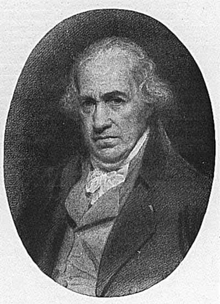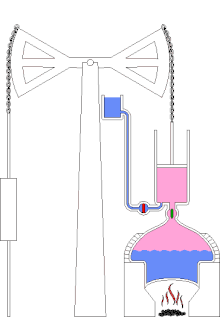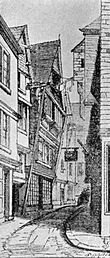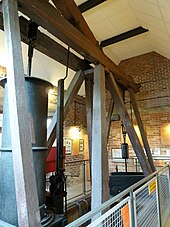After Newcomen
The Newcomen engine held its place without material change for about 75 years, spreading gradually to more areas of the UK and mainland Europe. At first brass cylinders were used, but these were expensive and limited in size. New iron casting techniques pioneered by the Coalbrookdale Company in the 1720s allowed bigger cylinders to be used, up to about 6 feet (1.8 m) in diameter by the 1760s. Experience led to better construction and minor refinements in layout. Its mechanical details were much improved by John Smeaton, who built many large engines of this type in the early 1770s; his improvements were rapidly adopted. By 1775, about 600 Newcomen engines had been built, although many of these had worn out before then, and been abandoned or replaced.
The Newcomen Engine was by no means an efficient machine, although it was probably as complicated as engineering and materials techniques of the early 18th century could support. Much heat was lost when condensing the steam, as this cooled the cylinder. This did not matter unduly at a colliery, where unsaleable small coal (slack) was available, but significantly increased the mining costs where coal was not readily available, as in Cornwall. Newcomen's engine was gradually replaced after 1775 in areas where coal was expensive (especially in Cornwall) by an improved design, invented by James Watt, in which the steam was condensed in a separate condenser. The Watt steam engine, aided by better engineering techniques including Wilkinson's boring machine, was much more fuel efficient, enabling Watt and his partner Matthew Boulton to collect substantial royalties based on the fuel saved.
Watt subsequently made other improvements, including the double-acting engine, where both the up and down strokes were power strokes. These were especially suitable for driving textile mills, and many Watt engines were employed in these industries. At first attempts to drive machinery by Newcomen engines had mixed success, as the single power stroke produced a jerky motion, but use of flywheels and better engineering largely overcame these problems. By 1800, hundreds of non-Watt rotary engines had been built, especially in collieries and ironworks where irregular motion was not a problem but also in textile mills.
Despite Watt's improvements, Common Engines (as they were then known) remained in use for a considerable time, and many more Newcomen engines than Watt ones were built even during the period of Watt's patent (up to 1800), as they were cheaper and less complicated. Of over 2,200 engines built in the 18th century, only about 450 were Watt engines. Elements of Watt's design, especially the Separate Condenser, were incorporated in many "pirate" engines. Even after 1800 Newcomen type engines continued to be built and condensers were added routinely to these. They were also commonly retro-fitted to existing Newcomen engines (the so-called "pickle-pot" condenser).



